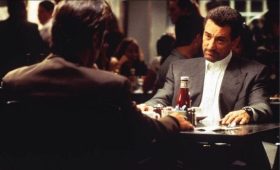Alexander Swords is a writer and narrative designer, though he describes himself as ‘a structuralist writer at heart’. He has over 20 years of experience working with stories, and bridging the gap between creator and audience.
Even though he has always had an interest in storytelling in video games, Swords started off working in the film and television industries before moving into the world of gaming, while also being a filmmaker and installation artist.
For Swords, narrative designers are advocates of the place of story in video games, people who have a clear understanding of their audience and are able to construct non-linear frameworks of narratives through gameplay. He sees much potential in the booming industry around emotional games (some of which are also known as “wholesome” games) and games for change, which are going some way to dispel the stigma that video games are all about violence and adrenaline.
Currently, he is a guest lecturer at the Australia’s leading, National Institute of Dramatic Art (NIDA), hosts writing for games workshops for industry bodies and is working on projects including the poetic fantastical world of Totem Teller.
Swords explains his role in video game production and why narrative design isn’t just about world building.
How would you describe what you do?
The role of a narrative designer came about from the need for a champion of story in video game development to advocate for how that story is told through game design in the project.
Where a film rolls through from beginning to end, games require many systems to produce content for the player, and these systems are interacting all the time. This may be something as simple as a dialogue system, through to the complex procedural AI systems used to drive NPC (non-player character) behaviour.
A narrative designer is responsible for working with the game designer to ensure these systems also tell the story, as well as make room for any purely narrative content that may be required. Often we’ll also work with a writer who can focus on the craft of writing without having to worry so much about all the systems.
How did you get started in your career as a narrative designer?
I’d always wanted to do story in video games, ever since playing the original Myst. The closest I could get at the time was to aspire to film and television, so that was my first degree out of high school. I also decided to do business as a “real degree” according to my mum, but I called it a back-up plan. Later, I would find the learning about marketing, product and organisational behaviour very valuable.
Out of university I landed a job in the control room of Big Brother – technically my first narrative design job. I was responsible for understanding how stories emerged from the players, while they navigated the systems of the game, and which were the important ones that needed to be followed to go into the various shows. I ended up out of film and television production altogether a few years later, and started working with audiences at various festivals and events, while developing my own art, which included interactive installation pieces.
Read: Occupy White Walls is democratising art with video games
After attending a screening of one of my short films at a festival in Berlin, I realised there were many more opportunities there, so a year later I moved. One of those opportunities turned out to be working in video games as there was a thriving scene there, and many of the developers were making games for the US market.
I would say that I started out as a writer in games, and then the more I learned, the more I realised my understanding of storytelling in the medium needed to include the language of the medium – gameplay. As a bit of a structuralist writer at heart, I was able to learn on the job, and my role expanded along with my expertise.
What’s an average day or week like? Do you often work with a large team?
I work in ACMI X, ACMI’s co-working and residency program at Federation Square (Melbourne, Australia) as I work mostly remote with smaller indie teams (usually two or three developers). This helps me stay inspired, learn from other residents and maintain my mental health. My days and weeks are usually dominated by the more design side of narrative design – developing flowcharts and diagrams that explain how the story needs to unfold and what contact it needs with the game design systems to work. This will also include character, event, feature and location briefs to support what is in those diagrams. I then use all of this to do the creative collaboration with the rest of the team.
Depending on the phase of production, sometimes I do get days or weeks of writing the actual player-facing content. I rarely work in a game engine, and if I do it is only to navigate around the world spaces to understand the implications for narrative. I also don’t have to code, usually relying on a tool like Twine to do my implementation, although I have done visual scripting in the past. I’ll also occasionally test content with a small trusted group of people.
What’s the most common misconception about being a narrative designer?
The biggest one I see, is that narrative design and writing in games is all about world building. That we get to start with an idea for a world, and then populate it with things we imagine. That has never really been the case with the work that I do. The world only exists to deliver the story that we want to tell the audience. This means that in my work it starts with an understanding of our audience, that then shapes the story, that then informs how that world needs to come together to serve them both.
Read: So you want my arts job: actor
Can you explain a little bit about your work in emotional games and games for change?
Broadly speaking, the purpose of emotional games is to move people – the story and gameplay work to elicit an emotional reaction. In this sense, the idea of “fun” may even take a back seat to these other emotions.
This is certainly the case with Totem Teller. My narrative design must account for the literal poetry in the game and the art that goes alongside it to perform the function of art, while still incorporating the more conventional aspects of level design and gameplay. This has required the latter to be stripped back so that it doesn’t interfere with the aesthetic impact of the poetry and art. It also requires a different understanding of player motivation. Most of the conventional models are based on fight or flight, whereas a relatively new motivational model, based on “tend and befriend” behaviour, often does better at explaining why audiences are drawn to emotional experiences.
Games for change is simpler in some ways. The narrative design must be consistent with the research, models and factual material of the game’s subject. Often this is about seeing where the overlap of those models are with the gameplay systems, and then elements of story and spaces to tell it become pretty apparent. As a structuralist, this all makes a lot of sense to me, and I now use a model for learning to create the onboarding experiences and tutorials for the games for entertainment that I work on.
Both of these are growing sectors. While not all emotional games are wholesome, the genre of wholesome games has grown strongly over the last couple of years. Similarly, games for change have seen a lot of growth now that more research has been done on how effective they are at helping to educate and contribute to society.
If you were interviewing someone for your job, what skills and qualities would you look for?
The most important thing would be curiosity about story and how it functions. I’ve shifted from the idea of there being rules for storytelling to recognising patterns that can be used, reversed, blended or repeated. Someone who has already done their own research about conventions for storytelling from around the world and our First Nations Peoples, and have been able to make their own observations would be perfect.
Next, would be someone who can communicate well, especially in diagrams, flowcharts and spreadsheets. A lot of this job is developing ideas, clarifying them and then communicating them and, because of the many iterations required to develop games, there are no locked versions. Things are constantly evolving.
Read: How video games are bringing orchestral music to new ears
Writing experience helps. Theatre folks tend to adapt better to games because they seem to have an inherent understanding that the role of the protagonist will be taken up by the player, and wield an economy of expression through setting. This would also have to be demonstrated in a sample – not just an interactive story in something like Twine, but also the planning that went into it.
I’d also expect them to be able to empathise with the player, and to understand that the storytelling in games is really a partnership between us and the player, and that we need to take care of them.
What’s the best thing happening in your field at the moment?
Audiences have segmented, and narrative games are maturing to cater to that audience. Not only the wholesome game genre, but what are sometimes called “Sunday afternoon games” – with great stories, mechanics that drive them forward without too much fear of failure and can be done in three to five hours.
These smaller titles are also usually made by more diverse teams, with representation in the game. It’s all helping to shift the perception of what games are, away from the focus on violence, and in the process are attracting a wider range of storytellers curious about the medium. For me personally this means, in every workshop I give, I see the immense and diverse writing talent we have in Australia, and I get the sense that we’ve just scratched the surface.





